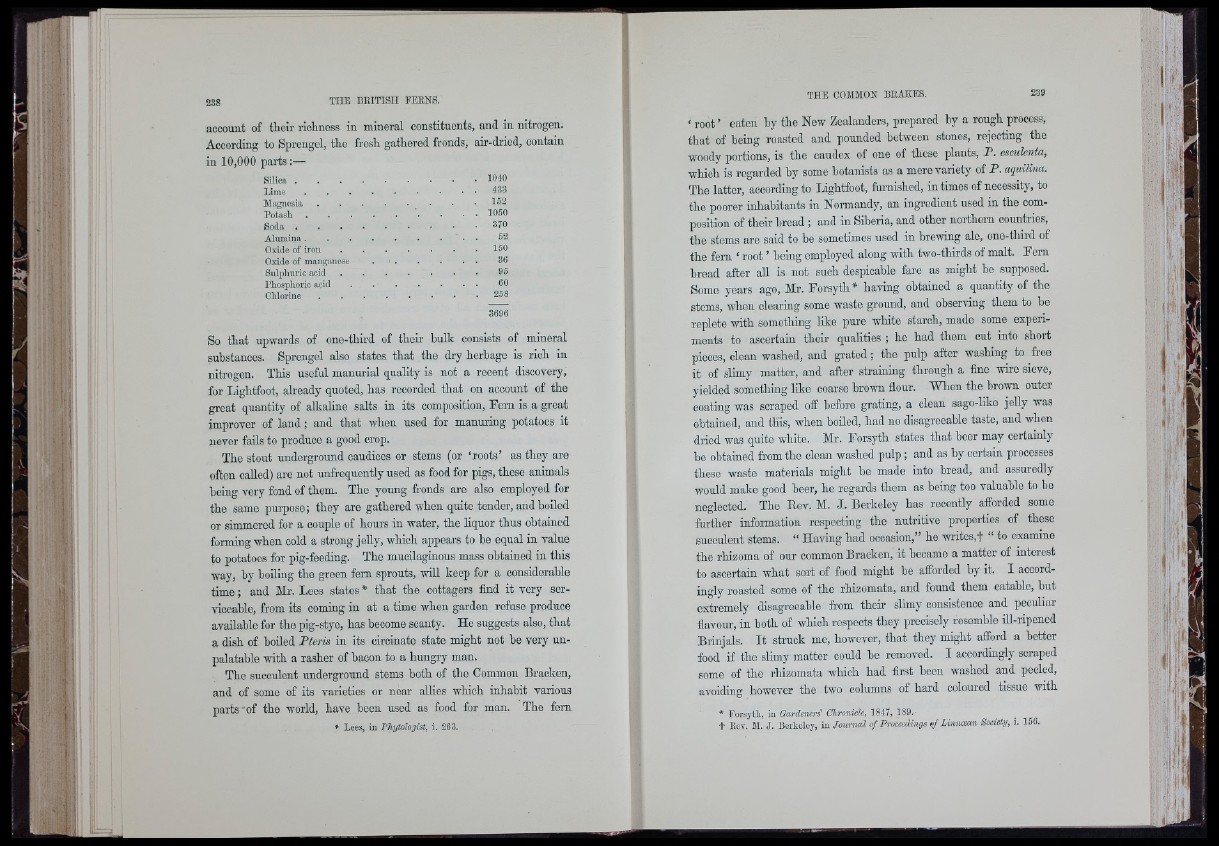
account of their richness in mineral constituents, and in nitrogen.
According to Sprengel, the fresh gathered fronds, air-dried, contain
in 10,000 parts
S i l i c a ........................................................................................ 1040
L i m e ...............................................................................
M a g n e s i a ................................................................................1^2
F o t a s h ..................................................■. . . . 1050
S o d a .......................................................................................... 370
A h u u in a .........................................................................................52
Oxide of iron . . . . . . . 150
Oxide of m a n g a n e s e ......................................................... 36
Sulpliuric a c i d ........................................................................ 95
Pliosplioric a c i d ....................................................................60
C l i l o r i n e ................................................................................ 258
So that upwards of ono-third of their bulk consists of mineral
substances. Sprengel also states that the dry herbage is rich in
nitrogen. This useful manurial quality is not a recent discovery,
for Lightfoot, already quoted, has recorded that on account of the
great quantity of alkaline salts in its composition. Fern is a great
improver of land; and that when used for manuring potatoes it
never fails to produce a good crop.
The stout underground caudices or stems (or ‘roots’ as they are
often called) are not unfrequently used as food for pigs, these animals
being very fond of them. The young fronds are also employed for
the same purpose; they are gathered when quite tender, and boiled
or simmered for a couple of hours in water, the liquor thus obtained
forming when cold a strong jelly, which appears to he equal in value
to potatoes for pig-feeding. The mucilaginous mass obtained in this
way, by boiling the green fern sprouts, wiU keep for a considerable
time ; and Mr. Lees states * that the cottagers find it very serviceable,
from its coming in at a time when garden refuse produce
available for the pig-stye, has become scanty. He suggests also, that
a dish of boiled Pteris in its circinate state might not be very unpalatable
with a rasher of bacon to a hungry man.
The suconlent underground stems both of the Common Bracken,
and of some of its varieties or near allies which inhabit various
parts of the world, have been used as food for man. The fern
* Lees, in Phytologist, i. 263.
‘ root ’ eaten by the New Zealanders, prepared by a rough process,
that of heing roasted and pounded between stones, rejecting the
woody portions, is the caudex of one of those plants, P . esculenta,
which is regarded by some botanists as a mere variety of P . aquilina.
The latter, according to Lightfoot, furnished, in times of necessity, to
the poorer inhabitants in Normandy, an ingredient used in the composition
of their bread ; aud in Siberia, and other northern countries,
the stems are said to be sometimes used in brewing ale, one-third of
the fern ‘ root ’ hoing employed along with two-thirds of malt. Fern
bread after all is not such despicable fare as might be supposed.
Some years ago, Mr. Forsyth* having obtained a quantity of the
stems, when clearing some waste ground, aud observing them to be
replete with something like pure white starch, made some experiments
to ascertain thoir qualities ; he had them cut into short
pieces, clean washed, and grated; the pulp after wasHug to free
it of slimy matter, and after straining through a fine wire sieve,
yielded something like coarse brown flour. When the brown outer
coating was scraped off before grating, a clean sago-like jelly was
obtained, and this, when boiled, had no disagreeable taste, and when
dried was quite white. Mr. Forsyth states that beer may certainly
be obtained from tbe clean washed pulp ; and as by certain processes
these waste materials might be made into bread, and assuredly
would make good beer, he regards them as heing too valuable to be
neglected. The Rev. M. J. Berkeley has recently afforded some
further information respecting the nutritive properties of these
succulent stems. “ Having had occasion,” ho writes,! “ to examine
the rhizoma of our common Bracken, it became a matter of interest
to ascertain what sort of food might be afforded by it. I accordingly
roasted some of the rhizomata, and found them eatable, but
extremely disagreeable from thoir slimy consistence and peculiar
flavour, in both of which respects they precisely resemble ill-ripened
Brinjals. It struck me, however, that they might afford a bettor
food if the slimy matter could he removed. I acoordingly scraped
some of the rhizomata which had first been washed and peeled,
however the two columns of hard coloured tissue with
* Forsytli, in Qarckmrs' Ohrmide, 1847, 189.'
+ Rov. M. J. Berkeley, hi Jm r n a l o f Proceedings e f Lmnceari Society, i. 156.
MU
1 \
ir; iiS
f ' if-
^ m
IHif
li
fi
■" il 1 Sill